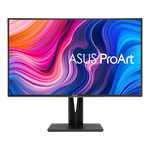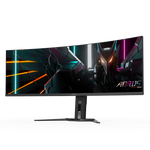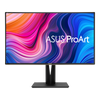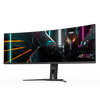A comparison of specs, key information, reviews, and best pricing from top retailers
Last updated -- hours ago | Report incorrect information
What we think

The PerfectRec monitor team Learn more
Updated April 23, 2024·
If you prioritize color accuracy for professional photo editing, the Asus PA329C with its strong coverage of color gamuts and an adjustable stand would serve you well. However, if you're looking for an immersive experience in HDR gaming and media consumption with top-notch contrast and brightness, the Gigabyte CO49DQ offers a wider screen and superior color performance, but at a higher cost. The Asus might be preferred for productivity thanks to its higher resolution and more traditional aspect ratio, while the Gigabyte's ultrawide format could be less ideal for some productivity tasks, but offers an expansive field of view for gaming and watching videos. Give Feedback
this description is based on the product variant with some specs and product variant with some specs. At the time of writing, the variant with some specs cost some dollars and the variant with some specs cost some dollars.
Advantages of the Asus PA329C (IPS)
- Good for productivity
- Good text clarity
- Good image clarity
Advantages of the Gigabyte CO49DQ (QD-OLED)
- Best in class for casual gaming
- Best in class for media consumption
- Best in class contrast
- Best in class brightness
- Best in class color volume
- Best in class response time
Key differences
Casual Gaming
5.9


9.9
3840 x 2160
RESOLUTION
5120 x 1440
60Hz
REFRESH RATE
144Hz
1000:1
NATIVE CONTRAST
Inf:1
400 nits
SDR PEAK BRIGHTNESS
1000 nits
Unknown
HDR PEAK BRIGHTNESS
Unknown
98.0 %
DCI-P3 COLOR GAMUT
99.0 %
Matte
COATING
Matte
The Gigabyte CO49DQ (QD-OLED) is best in class for casual gaming, while the Asus PA329C (IPS) is poor.
Competitive Gaming
3.8


5.5
60Hz
REFRESH RATE
144Hz
10.0 ms
TOTAL RESPONSE TIME
0.0 ms
24 - 76 Hz
VARIABLE REFRESH RATE
48 - 144 Hz
No
STROBING / BFI
No
400 nits
SDR PEAK BRIGHTNESS
1000 nits
The Gigabyte CO49DQ (QD-OLED) and Asus PA329C (IPS) are both poor for competitive gaming, though the Gigabyte CO49DQ (QD-OLED) is somewhat better.
Productivity
7.8


5.8
3840 x 2160
RESOLUTION
5120 x 1440
137 PPI
PIXELS PER INCH
108 PPI
Yes
ADJUSTABLE STAND
No
Matte
COATING
Matte
The Asus PA329C (IPS) is good for productivity, while the Gigabyte CO49DQ (QD-OLED) is poor.
Media Consumption
6.7


9.8
3840 x 2160
RESOLUTION
5120 x 1440
1000:1
NATIVE CONTRAST
Inf:1
400 nits
SDR PEAK BRIGHTNESS
1000 nits
Unknown
HDR PEAK BRIGHTNESS
Unknown
Matte
COATING
Matte
The Gigabyte CO49DQ (QD-OLED) is best in class for media consumption, while the Asus PA329C (IPS) is only fair.
Cost
$1,000


$1,100
$400
$600
$800
$1,000
$1,200
$1,400
$1,600
$1,800
The Asus PA329C (IPS) has a price of $1,000 and the Gigabyte CO49DQ (QD-OLED) costs $1,100.
HDR Gaming and Media Consumption
No


Yes
The Asus PA329C (IPS) is not suitable for HDR gaming and media consumption while the Gigabyte CO49DQ (QD-OLED) is suitable for HDR gaming and media consumption.
HDR Video Editing and Color Grading
No


Yes
The Asus PA329C (IPS) is not suitable for HDR video editing and color grading while the Gigabyte CO49DQ (QD-OLED) is suitable for HDR video editing and color grading.
Key similarities
Digital Photo Editing
Yes


Yes
Both the Asus PA329C (IPS) and Gigabyte CO49DQ (QD-OLED) are suitable for digital photo editing.
Print Photo Editing
Yes


Yes
Both the Asus PA329C (IPS) and Gigabyte CO49DQ (QD-OLED) are suitable for print photo editing.
Give feedback
We’re constantly working to improve.
How the Asus PA329C (IPS) and the Gigabyte CO49DQ (QD-OLED) compare to other monitors
Spec Comparison
| Asus PA329C (IPS) | Gigabyte CO49DQ (QD-OLED) |
GENERAL | |||
|---|---|---|---|
| Price | |||
$1,000 | $1,100 | ||
Screen Size | |||
Screen Size | 32" | 49" | |
Resolution | |||
Resolution | 3840 x 2160 | 5120 x 1440 | |
Screen Type | |||
Screen Type | LED | OLED | |
Screen Sub-type | |||
Screen Sub-type | IPS | QD-OLED | |
Refresh Rate | |||
Refresh Rate | 60Hz | 144Hz | |
COLOR, CONTRAST & BRIGHTNESS | |||
|---|---|---|---|
Native Contrast | |||
Native Contrast | 1000:1 | Inf:1 | |
SDR Peak Brightness | |||
SDR Peak Brightness | 400 nits | 1000 nits | |
HDR Peak Brightness | |||
HDR Peak Brightness | Unknown | Unknown | |
Suitable for HDR Gaming and Media Consumption | |||
Suitable for HDR Gaming and Media Consumption | No | Yes | |
sRGB Color Gamut | |||
sRGB Color Gamut | 100 % | 153.1 % | |
MOTION CHARACTERISTICS | |||
|---|---|---|---|
Total Response Time | |||
Total Response Time | 10 ms | 0.03 ms | |
Variable Refresh Rate | |||
Variable Refresh Rate | 24 - 76 Hz | 48 - 144 Hz | |
Strobing / BFI | |||
Strobing / BFI | No | No | |
Persistence Blur Score | |||
Persistence Blur Score | 5/10 | 6.6/10 | |
Ghosting Score | |||
Ghosting Score | 7.1/10 | 10/10 | |
TEXT & IMAGE CLARITY | |||
|---|---|---|---|
Pixels Per Inch | |||
Pixels Per Inch | 137 PPI | 108 PPI | |
Coating | |||
Coating | Matte | Matte | |
Text Clarity Score | |||
Text Clarity Score | 7.9/10 | 6.6/10 | |
Image Clarity Score | |||
Image Clarity Score | 7.9/10 | 7/10 | |
PORTS & CONNECTIVITY | |||
|---|---|---|---|
HDMI 1.4 Ports | |||
HDMI 1.4 Ports | 0 | 0 | |
HDMI 2.0 Ports | |||
HDMI 2.0 Ports | 2 | 0 | |
HDMI 2.1 Ports | |||
HDMI 2.1 Ports | 0 | 2 | |
Micro HDMI Ports | |||
Micro HDMI Ports | 0 | 0 | |
DisplayPort 1.2 Ports | |||
DisplayPort 1.2 Ports | 1 | 0 | |
Shopping
Asus PA329C (IPS)
See more
Dig into reviews and images
Photoblographer
Feroz Khan | February 2022
"Even at 32 inches, it’s just five inches larger than most professional display monitors, the ASUS ProArt Display PA329CV monitor seems a lot bigger. The color accuracy on the unit I received was excellent, and viewing high-resolution image files on it was pleasing to the eyes. It’s Calman verified, so you can be assured of Hollywood studio-quality color straight out of the box. With multiple USB ports on the monitor and HDMI and USB-C connectivity options, it stands up to the well-established Benq PhotoVue series of monitors."
Give feedback
We're constantly perfecting our model
More comparisons for you
Compare Asus PA329C (IPS) vs. LG 27GR95QE (W-OLED)
VS
Compare Asus PA329C (IPS) vs. Acer X27U (W-OLED)
VS
Compare Asus PA329C (IPS) vs. ViewSonic VX2776 2K OLED (W-OLED)
VS
Compare Gigabyte CO49DQ (QD-OLED) vs. Asus XB273U F (IPS)
VS
Compare Gigabyte CO49DQ (QD-OLED) vs. LG 32GS95UE (W-OLED)
VS
Compare Gigabyte CO49DQ (QD-OLED) vs. MSI MPG 491CQP (QD-OLED)
VS
FAQs
Why trust us
This information was produced and vetted by the PerfectRec monitors team. We are a product research and recommendation organization that meticulously reviews and evaluates the latest monitor information and makes it digestible for you.
By the numbers
210
Monitors evaluated
10,500
Monitors stats compiled
15
Proprietary Monitors ratings developed
117,200
Recommendations made
17,580
Consumer hours saved
About the monitor team
Joe Golden, Ph.D
CEO and Monitors Editor
Joe is an entrepreneur and lifelong electronics enthusiast with a Ph.D in Economics from the University of Michigan.
Jason Lew
Staff Expert & Software Engineer
Jason is a staff expert and software engineer that has been making laptop recommendations for 7 years and moderates one of the largest laptop subreddits.
Chandradeep Chowdhury
Staff Expert & Software Engineer
Chandradeep is a staff expert and software engineer and expert in televisions and monitors. He’s been making monitor recommendations for ten years.







